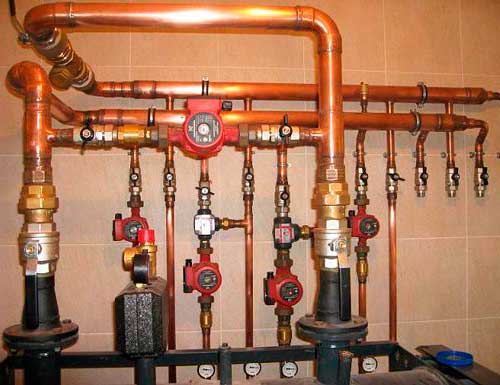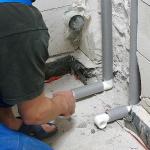Houses in the private sector can be heated using various types of boilers. It can be electric, diesel, solid fuel and, of course, gas. For the most part, owners of private houses prefer to install gas equipment.
The reason for everything is the price - gas is the most inexpensive type of fuel. Of course, the gasification process itself is an expensive pleasure. But the savings in paying for heating will quickly cover the cost of installing gas equipment.
In the event that you have firmly decided to gasify your home, you need to know what you need for this: permits, what work is to be done, the price of this issue.
 Everyone understands that gasification of a private house is necessary subject to certain rules and regulations.
Everyone understands that gasification of a private house is necessary subject to certain rules and regulations.
As a rule, the process of gasification in this settlement will be carried out if there is a laid pipeline.
In this case, the project will include 2 points:
- how to connect to it
- calculations of the duration of the pipes that will be required to supply gas to the house itself.
In the absence of a highway in your locality, an autonomous gasification project may be developed. In this state of affairs, in addition to the above, it is necessary to determine the location of the gas tank, as well as the existing methods for connecting the boiler to it.
Requirements for gasification at home
 Gasification of the private sector is carried out in accordance with the standards established by law.
Gasification of the private sector is carried out in accordance with the standards established by law.
You can get permission to crash into the highway or connect if all the conditions are met:
- on the property rights you are the owner of the house and the plot;
- there is a room in your house that meets the established requirements for installing a boiler.
There are also certain requirements for the room where the boiler with a power of up to 60 kW will be installed:

Subject to all the above conditions, we proceed to the collection of documents for gasification.
You will need:

- first on the list will be a visit to the local architectural and planning department. They are in charge of gasification of private houses. You must obtain written permission from this organization.
- the next visit will be a visit to the fire service or housing and communal services. This is followed by a call to the house of the inspector, who will inspect the chimney. After that, subject to all requirements, i.e. the presence and working capacity of the chimney, the inspector issues the corresponding act to the owner.
- the next on the list will be a visit to the local Gorgaz or Oblgaz branch and obtaining technical conditions for conducting gas to the house. In this instance, you need to write an application on the provided form. It will require an indication of the approximate volume of gas consumption per hour. Such an application is considered for 2 weeks. After that, the owner will receive technical specifications.
After reading the documents, it will be useful to know what types of gas pipelines exist, their advantages and disadvantages.
According to how the gas pipeline will be located relative to the ground, underground and aboveground are distinguished, their difference is in the method of entering into the building not only internal gas supply networks and risers, but also all gas-consuming devices.
Consider an underground gas pipeline
 Building a gas pipeline underground is more expensive than above ground (approximately 60%). But he does not lose his popularity. The explanation for this is quite logical - such pipes have the greatest protection, compared with above-ground ones, and a longer service life. They are less hazardous to the environment.
Building a gas pipeline underground is more expensive than above ground (approximately 60%). But he does not lose his popularity. The explanation for this is quite logical - such pipes have the greatest protection, compared with above-ground ones, and a longer service life. They are less hazardous to the environment.
It should be borne in mind that when laying an underground gas pipeline, either a partial restriction of traffic on a separate section of the road or a complete blocking of traffic is required. For this, the necessary schemes are drawn up by the installation organization. The next step will be the coordination with the traffic police department of the scheme for restricting traffic and blocking the places where the work on laying the gas pipeline will be carried out. After passing the approval procedure, an order is issued to perform this kind of work.
Gas pipeline above ground
 Second view- a gas pipeline laid above the ground, which also has its pros and cons. The negative side in such a gas pipeline can be called the susceptibility to corrosion of open sections of the gas pipeline, as well as the ease of unauthorized connection. In this regard, an underground gas pipeline is considered reliable.
Second view- a gas pipeline laid above the ground, which also has its pros and cons. The negative side in such a gas pipeline can be called the susceptibility to corrosion of open sections of the gas pipeline, as well as the ease of unauthorized connection. In this regard, an underground gas pipeline is considered reliable.
Let's compare two types of gas pipeline, because knowing some of the nuances, you will make the right decision:
- When it is known that in your locality, the soil is characterized by high rates of corrosion, in such a situation it would be most correct to give preference to an above-ground gas pipeline.
- If your house is located near a high-voltage power line, in this situation it is worth giving preference to installing an underground gas pipeline.
- In the case when, during the underground laying of a gas pipeline, it will be necessary to lay a gas pipeline throughout the entire section of the neighbors, in order to avoid unnecessary misunderstandings and obtain permission from the neighbors, it would be appropriate to choose an above-ground type of gas pipeline.
- In a situation where the laying of the gas pipeline will pass through the road, it is possible to combine the gas pipeline: make the section under the road underground, and on the land plot - aboveground.
Giving preference to one or another type of gas pipeline, it is worth understanding which pipes are used for laying the gas pipeline. In the recent past, pipes for the gas pipeline were only steel. Today, polyethylene pipes have gained popularity; they do not lose at all to steel pipes.
Types of pipes for a gas pipeline
Plastic pipes are characterized by many advantages: 
- They have increased resistance to the negative effects of various chemical compounds, as well as environmental factors.
- Their strength is combined with sufficient ductility, which makes it possible to lay a gas pipeline in settlements with a particularly harsh climate (at temperatures up to minus 45 ° C, such pipes retain impact strength).
- Because plastic does not conduct electricity, polyethylene pipes are insensitive to the action of stray currents, which means they have reliable protection against electrochemical damage. It is for this reason that such pipes do not require additional protection when laid in the ground;
- The mass of polyethylene pipes is seven times less than steel pipes. What is important, they are delivered in special compact bays, which greatly simplifies transportation;
- It is easy and convenient to install these pipes
- The service life of polyethylene pipes exceeds that of steel pipes by two, and sometimes three times, and reaches 50 years or more.
Must be remembered! The introduction of pipes into the house and their separation in the house is carried out only with steel pipes.
Like all products, polyethylene pipes have certain limitations:
- In areas where the air temperature drops below 45 ° C, as well as in areas with seismicity exceeding 6 points, it is forbidden to use polyethylene pipes when laying a gas pipeline;
- The use of polyethylene pipes when laying a gas pipeline is prohibited both above and on the ground, in channels, tunnels and collectors, as well as in buildings;
- It is forbidden to lay a gas pipeline from such pipes in the area where it is planned to arrange crossings through artificial or natural barriers.
Types of boilers or how to make the right choice?
 Next, it is worth considering the types of boilers in order to make the right choice. The modern market provides a huge selection of gas equipment. There are two types of boilers: wall and floor.
Next, it is worth considering the types of boilers in order to make the right choice. The modern market provides a huge selection of gas equipment. There are two types of boilers: wall and floor.
The wall-mounted gas boiler is compact, has a built-in automatic security system, an expansion tank and circulation pumps, and, importantly, a relatively low cost.
Usually, their purpose is to heat a room, the total area of \u200b\u200bwhich is not more than 150 square meters. meters and providing two taps with hot water.
A distinctive feature of floor gas boilers- ample opportunities for choosing the power of equipment, the function of which will be heating a room larger than 150 sq. meters. Such a boiler will be able to ensure the proper supply of hot water with the additional installation of a boiler.
 Heat exchangers in boilers are made of cast iron or steel. The cast iron heat exchanger has a long service life (approximately 20 to 25 years, compared to steel from 10 to 15 years), which provides a high rate of corrosion resistance.
Heat exchangers in boilers are made of cast iron or steel. The cast iron heat exchanger has a long service life (approximately 20 to 25 years, compared to steel from 10 to 15 years), which provides a high rate of corrosion resistance.
The cast iron heat exchanger usually consists of sections, this gives an advantage in case of an accident. Those. not the entire boiler is dismantled, only damaged areas are insulated. It must be remembered that such a boiler is characterized by high mechanical and thermal sensitivity. In this regard, it is possible to feed with cold water only if the heat exchanger has completely cooled down.
 Compared with the above boiler, the gas boiler with steel heat exchanger has advantages in terms of cost and is lighter in weight. A distinctive feature of a boiler with a steel heat exchanger is resistance to mechanical stress, but a negative feature is susceptibility to corrosion. The weight of a boiler with a cast iron heat exchanger is 114 kilograms, and the weight of the same boiler with a steel heat exchanger is approximately 60 kilograms.
Compared with the above boiler, the gas boiler with steel heat exchanger has advantages in terms of cost and is lighter in weight. A distinctive feature of a boiler with a steel heat exchanger is resistance to mechanical stress, but a negative feature is susceptibility to corrosion. The weight of a boiler with a cast iron heat exchanger is 114 kilograms, and the weight of the same boiler with a steel heat exchanger is approximately 60 kilograms.
Another type of boilers is non-volatile and volatile.
Boilers with energy independence are characterized by natural circulation, but at the same time they have an impressive list of disadvantages:
- the pipeline itself has a large diameter,
- there is an open expansion tank,
- a special installation of the system is required to ensure the desired slope,
- the largest - there is no way to adjust the air temperature in the house.
At the same time, the room in which it is planned to install a boiler with an open combustion chamber must be provided with tidal and exhaust ventilation, as well as a chimney.
 If we talk about volatile boilers, they are equipped with a closed expansion tank, circulation pumps and full electronic automatic boiler control. In this regard, they can undoubtedly be called a mini-boiler room.. But at the same time, one should take into account the important fact that ensuring the uninterrupted operation of the entire heating system depends on a stable mains voltage of 230 ± 10% in the presence of a voltage stabilizer.
If we talk about volatile boilers, they are equipped with a closed expansion tank, circulation pumps and full electronic automatic boiler control. In this regard, they can undoubtedly be called a mini-boiler room.. But at the same time, one should take into account the important fact that ensuring the uninterrupted operation of the entire heating system depends on a stable mains voltage of 230 ± 10% in the presence of a voltage stabilizer.
For boilers with a natural prerequisite for the smooth operation of heating gas equipment becomes a chimney. They are internal, passing through the ceiling and roof of the house itself, as well as external, which are mounted along the outer surface of the wall.
Only a specialist can choose the optimal chimney
 The consumer only needs to know a few simple rules:
The consumer only needs to know a few simple rules:
- the diameter of the boiler neck should not be larger than the inner diameter of the chimney;
- the minimum number of all kinds of bends and knees in the path of flue gases;
- when installing the chimney, it is necessary to ensure conditions that exclude the formation of condensate.
Chimneys made of stainless steel are optimal in terms of quality and price.
They can be single layer or double layer. Single-layer are used for laying a chimney indoors. Their significant drawback is the formation of abundant condensate, which is formed when modern gas heating facilities are used to remove flue gases.
Double-layer chimneys, made of two layers of steel, the space between which is filled, such a device reduces the amount of condensate that forms.
It must be remembered that the choice of a chimney depends on the power of the boiler, the temperature of the outlet of the combustion products, the material of the shaft and its insulation, as well as other factors affecting such indicators as draft, safety, durability and reliability of the chimney.
When we have decided on the equipment, we proceed to the development of the project
 Either employees of Gorgaz or design engineers of any specialized organization deal with this issue..
Either employees of Gorgaz or design engineers of any specialized organization deal with this issue..
The development of the project includes drawing up a scheme for laying pipes to the house, determining the place where the line enters the house.
The cost of the procedure depends on the length of the pipes that will be used to connect your home to the gas pipeline.
With autonomous gasification, which is carried out using a gas tank, the project determines the installation location of such.
 Choosing a site for the installation of a gas tank, you need to take into account the following requirements: it is located no closer than 2 meters from the fence of the site and no closer than 5 meters from the building itself.
Choosing a site for the installation of a gas tank, you need to take into account the following requirements: it is located no closer than 2 meters from the fence of the site and no closer than 5 meters from the building itself.
When the process of drafting the project is over, it is required to coordinate it with the technical department of the organization involved in the supply of gas to the region, the next stage is the signing of an agreement with the organization for connection work. Upon completion of connecting the house to the highway, the owners of the house, among other things, must conclude an agreement for the maintenance of equipment.
Connecting a house to a centralized highway is not a cheap pleasure.
The total cost of gasification includes:
- collection of documents, which includes payment of various state duties;
- drawing up a project, the price of developing a project depends on the degree of its complexity and can vary over a wide range
- laying out the gas pipeline
- tie-in to highway
- the price of the boiler, radiators, pipes, etc.
Autonomous gasification will cost, of course, even more expensive.
 When the house is connected to the highway, the owners of the property, of course, must strictly observe the rules for using gas equipment. The first time you can turn on the boiler only under the supervision of a specialist of the company with which you have concluded a service contract. All adult residents are required to undergo a safety briefing in Gorgaz.
When the house is connected to the highway, the owners of the property, of course, must strictly observe the rules for using gas equipment. The first time you can turn on the boiler only under the supervision of a specialist of the company with which you have concluded a service contract. All adult residents are required to undergo a safety briefing in Gorgaz.





